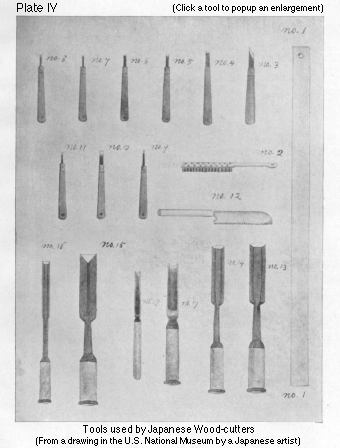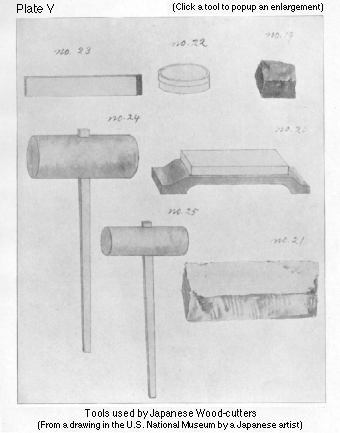Through the kindness of Mr. T. Tokuno, Chief of the Bureau of Engraving and Printing of the Ministry of Finance, Tokio Japan, the U.S. National Museum has received as a gift from the Imperial Government of Japan the complete outfit of a Japanese wood-cutting and wood-cut printing establishment, accompanied by illustrated descriptions of all the tools and materials sent and of the processes used by Japanese engravers and printers. The original statements made by Mr. Tokuno were supplemented by answers to questions addressed to him by me, and the patience and courtesy shown by this well-informed official can not be too highly appreciated and too warmly acknowledged. The publication of the information thus elicited will be welcomed by those who are interested in the art of the wood-cutter and in the arts of Japan, more especially as Mr. Tokuno's communication is, so far as I know, the first authoritative statement on this subject made by a native of Japan thoroughly qualified for the task. As the information which follows is scattered through a number of letters and memoranda, it will not be possible to give it absolutely in the shape in which it was received, but care will be taken to adhere as closely as possible to Mr. Tokuno's own statements. Occasional obscurities which still remain must be charged to the necessity of corresponding in English and to the great distance between the correspondents. The illustrations which accompany this paper, so far as they relate to Japanese wood-cutting and printing, were all made either from the objects themselves or from drawings by Japanese artists furnished by Mr. Tokuno. Such remarks as suggest themselves upon a comparison of our own methods, past and present, with those of Japan will be given as an appendix to Mr. Tokuno's communication.
The tools and specimens alluded to in the following pages have been placed on exhibition in the Hall of Graphic Arts, eastern side, alcove 2, in the square case on the floor of the alcove, and in frames 28 to 34.
THE WOODS USED AND THEIR PREPARATION. Although "tsuge," a variety of Buxus Japonica, or "adsusa" Catalpa Kaempferi var. Japonica, are employed, according to the degree of fineness of the written characters or pictures to be reproduced, the wood most generally used is "sakura," a variety of cherry. In all cases, however, the texture must be very fine and hard.
The wood is first cut into planks, and these are planed until they are perfectly level and smooth, free from all traces of the plane, and show some luster on the surface. Both sides are finished alike, as the woodcutter utilizes both of them.
Cut planks which are to be printed in black only are usually mounted between strips nailed to each end. There are several reasons for this. It prevents the warping of the planks; it gives free access to the air between them, when a number are stored on top of one another, and. provides the best means of keeping them dry and guarding against damage by insects; it prevents immediate contact of the blocks, and, finally, it is sometimes very convenient, as it facilitates the drawing out of such planks as may be needed from among many stored away together, the planks being marked or numbered on the sides of the strips. For color-printing, however, the same plank often has two or three designs upon it for different tints, and consequently has registering marks on different parts. In that case the end strips would be in the way, and are, therefore, omitted.
THE TOOLS OF THE ENGRAVER. For engraving, knives and chisels of the best quality are required. All the tools needed by the engraver are represented on Plates IV (1-18) and V (19-25), and with the following explanations their uses will be readily understood:

1. Ruler for cutting straight lines and for fixing the registering marks on the planks used in color-printing.
2. Brush for removing, from the plank the chips thrown out by the cutting tools.
3. Engraving knife, for cutting out the design. Only one knife, always of the same pattern and size, is used by the Japanese wood cutters, and with this one knife they perform all grades of work, from the coarsest to the finest, the execution depending entirely on the skill of the engraver. [See Fig. 1 for a Japanese woodcutter's knife, seen from both sides.]

4-9. Chisels for removing smaller portions of wood between the lines of the design. They are used exactly like the engraving knife.
10, 11. Chisels for correcting unsatisfactory parts [i.e., removing parts for "plugging"].
12. Saw for cutting small pieces of wood to be inserted in the plank where corrections have to be made.
13-16. Chisels for removing larger portions of wood.
17, 18. Semicircular chisels, used for the same purpose as 13-16.

19. A special kind of grinding stone, for leveling the surface of the grinding stone, No. 20.
20. Grinding stone for taking off the somewhat roughened edges of the knives and chisels, after they have been sharpened on the stone, No. 21.
21. Grinding stone. [See No. 20] [*1]
22. Oil pot, in which oil of Sesamum orientale is kept, for rubbing the portions of the plank to be cut, so as to soften the wood and make the cutting easier and cleaner.
23. Oil brush for the oil just spoken of.
24,25. Wooden mallets for driving the chisels, Nos. 13-18.